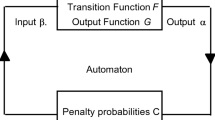Abstract
The purpose of this work is to show the strong connection between learning in the limit and the second-order adaptive automaton. The connection is established using the mutating programs approach, in which any hypothesis can be used to start a learning process, and produces a correct final model following a step-by-step transformation of that hypothesis by a second-order adaptive automaton. Second-order adaptive automaton learner will be proved to acts as a learning in the limit one.
Access this chapter
Tax calculation will be finalised at checkout
Purchases are for personal use only
Preview
Unable to display preview. Download preview PDF.
Similar content being viewed by others
References
Chater, N., Vitányi, P.: “Ideal learning” of natural language: positive results about learning from positive evidence. Journal of Mathematical Psychology 51(3), 135–163 (2007)
Dowe, D.L.: MML, hybrid Bayesian network graphical models, statistical consistency, invariance and uniqueness. In: Handbook of the Philosophy of Science (HPS). Philosophy of Statistics, vol. 7, pp. 901–982. Elsevier (2011)
Gold, E.: Language identification in the limit. Information and Control 10(5), 447–474 (1967)
Li, M., Vitányi, P.: Computational Machine Learning in Theory and Praxis. In: van Leeuwen, J. (ed.) Computer Science Today. LNCS, vol. 1000, pp. 518–535. Springer, Heidelberg (1995)
Li, M., Vitányi, P.: An introduction to Kolmogorov complexity and its applications, 3rd edn. Springer Publishing Company, Incorporated (2008)
Paul, W.J., Solomonoff, R.J.: Autonomous theory building systems. Technical Report D 6600, Computer Science Department, University of Saarbruecken, Germany (1990)
de Azevedo da Rocha, R. L., Neto, J.J.: Adaptive automaton, limits and complexity compared to the Turing machine - in Portuguese Autômato Adaptativo, Limites e Complexidade em Comparação com Máquina de Turing. In: Proceedings of the I Congress of Logic Applied to Technology, LAPTEC 2000, São Paulo, Faculdade SENAC de Ciências Exatas e Tecnologia, pp. 33–48 (2000)
Rubinstein, R.S., Shutt, J.N.: Self-modifying finite automata. In: Pehrson, B., Simon, I. (eds.) Proceedings of the 13th IFIP World Computer Congress, Amsterdam. Technology and Foundations: Information Processing 1994, vol. I, pp. 493–498. North-Holland (1994)
Salthe, S., Matsuno, K.: Self-organization in hierarchical systems. Journal of Social and Evolutionary Systems 18(4), 327–338 (1995)
Silva Filho, R.I., de Azevedo da Rocha, R.L.: Adaptive Finite Automaton: a New Algebraic Approach. In: Dobnikar, A., Lotrič, U., Šter, B. (eds.) ICANNGA 2011, Part II. LNCS, vol. 6594, pp. 275–284. Springer, Heidelberg (2011)
Solomonoff, R.J.: A formal theory of inductive inference. parts I and II. Information and Control 7(2), 224–254 (1964)
Solomonoff, R.J.: Does algorithmic probability solve the problem of induction? In D. L. Dowe, K. B. Korb, and J. J Oliver, editors. In: Dowe, D.L., Korb, K.B.,, J. (eds.) Proceedings of the Information, Statistics and Induction in Science (ISIS) Conference, Melbourne, Australia, pp. 7–8. World Scientific (August 1996)
Wallace, C.S.: Statistical and Inductive Inference by Mininum Message Length. Springer (2005)
Author information
Authors and Affiliations
Editor information
Editors and Affiliations
Rights and permissions
Copyright information
© 2013 Springer-Verlag Berlin Heidelberg
About this chapter
Cite this chapter
Inojosa da Silva Filho, R., de Azevedo da Rocha, R.L., Gracini Guiraldelli, R.H. (2013). Learning in the Limit: A Mutational and Adaptive Approach. In: Dowe, D.L. (eds) Algorithmic Probability and Friends. Bayesian Prediction and Artificial Intelligence. Lecture Notes in Computer Science, vol 7070. Springer, Berlin, Heidelberg. https://doi.org/10.1007/978-3-642-44958-1_8
Download citation
DOI: https://doi.org/10.1007/978-3-642-44958-1_8
Publisher Name: Springer, Berlin, Heidelberg
Print ISBN: 978-3-642-44957-4
Online ISBN: 978-3-642-44958-1
eBook Packages: Computer ScienceComputer Science (R0)




